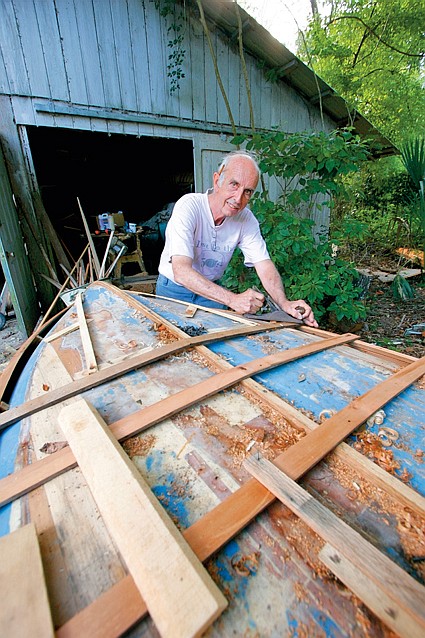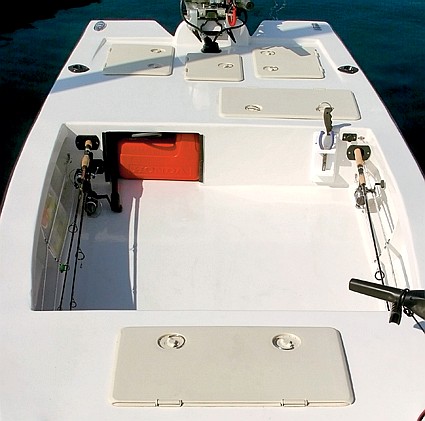March 06, 2013
By Tommy Thompson
Modernizing an old creek boat design for super-shallow applications.
I was delighted when I got the call. I was going out with some Skinny Dippers at Steinhatchee! But it wasn't what it seemed. It was daytime and my companions were going to be a bunch of guys! Skinny Dippers, appropriately named by the daughter of the builder, Ted Giesel, are just boats.
Well, not just boats, but an interesting design hybrid composed of an old Carolina creek boat hull Ted found rotting north of his home in Melrose and modern foam, fiberglass and Kevlar materials such as those used by the finest 21st Century boat builders.

Ted Giesel affixes cedar strips to a wooden hull, making a mold for another lightweight, glass-over-foam project skiff.
|
It seems Giesel, a retired college professor, has long had an interest in small boats and what makes them tick. His side yard and garage are full of re-builds of canoes, rowboats and small sailboats, making the Skinny Dipper the latest boat in a long line of successful backyard projects.

Giesel's first Skinny Dipper zips along at 24mph.
|
In fact, there are two Skinny Dipper boats. The first boat built by Ted is slightly heavier, as it's constructed with more fiberglass and no Kevlar. Even at a hull weight of 160 pounds, it's quite comfortable for both riding and fishing. The second boat, lighter at 120 pounds, with a tweaked hull design, rides smoother and still will self-bail its cockpit with 700 pounds of men and motor aboard. Most of us stand in awe of any 15-foot boat with a 5-foot beam that can be man-lifted onto its trailer. More of us stand there scratching our heads wondering how it can provide a soft, dry ride at 24 mph with a 15 hp 4-stroke Honda. And that's the heavier boat—Ted's second boat runs faster, smoother and shallower even with its old 2-stroke Evinrude.
The whole thing started when Ted mentioned to his friend, Rick Shultz, that, with some modifications to the hull's entry and the use of modern boat construction materials and techniques, his 60-year-old creek boat might make a workable flats skiff. Shultz, the not-so-proud owner of an aging Sears johnboat, agreed to finance the venture in exchange for the first hull.
The shape for the first boat was taken directly from the old creek boat hull, which was repaired and tested with Ted's old Evinrude. In tests, it ran shallow enough and was stable with two anglers aboard. The old wood boat was then flipped over and a series of 3/8-inch-thick cedar strips were attached to make the plug, or male mold. Of course, never being one to not experiment and a firm believer in the scientific method, Ted made some slight modifications to the hull's deadrise and length before completing the mold.
To ensure the lightest boat he could make using the mold (he had hoped for a 100-pound hull rather than the final 160-pound version), Ted did a thorough job of researching materials and settled on Divinycell foam for the sides and bulkheads and Corecell for the bottom. The foam was cut and attached to the frame using screws, then glassed into place. The screws were removed when the epoxy dried, and the hull was separated from the plug—ready for interior construction.
Once the hull was righted, the floor was added and all the interior bulkheads and decks were bonded in place. Then the hull was water-tested to be sure it floated. In terms of workload, Rick admits that Ted did all the work, while he added “moral support” and engineering advice regarding layout, wiring and drainage. Six months later, work progressing at a few-hours-a-day pace, the hull was moved from Ted's to Rick's garage for sanding, painting and rigging, while Ted started on the next boat. After a total of eight months, and at a cost of about $2,000 and 150 man-hours (of Ted's labor), Skinny Dipper Number One was finished.

Double Dippin'. Number One in front, Two in back.
|
The second Skinny Dipper, Giesel's personal boat, was changed slightly from the first boat in that more deadrise and a bit of width was added. Ted also decided on a livewell to suit his style of fishing. The tunnel and the rear sponsons, which give the boats the ability to plane quickly, were unchanged from the first boat. The partial use of Kevlar cloth rather than all fiberglass was a contributing factor to the second boat's decreased weight of 120 pounds. Experience paid off, too, as the second Skinny Dipper took only three months to build.
Hull number two is quite impressive. It's an honest 14 feet, 10 inches with a 58-inch beam. Empty, with no motor, it drafts one inch and is completely self-bailing. The boat is fitted with sealed under-deck spaces that give the hull a total of 700 pounds of flotation. The self-bailing feature was tested on the bare hull by Schultz's 10-year-old grandson, Joshua Knight, and his baseball team. The kids were tasked with filling the boat with water and trying to sink it. When they filled it to the top decks using 5-gallon buckets, they abandoned ship (and the project), and 40 minutes later the hull was empty of water—it had drained itself! As a result, the boat, fully loaded with two anglers, fuel, coolers and fishing gear, drafts four to five inches at rest. The boat's tunnel feature allows the engine to be trimmed up while on plane, putting the prop into the upward blast of water. This trims at least an inch of draft from the at-rest figure.
Numbers and hearsay are impressive, and I'll be the first to admit that Ted's claims regarding the Skinny Dippers were almost too good to be true. The real test is seeing any boat on the water, and in my case, being fished. It's good to look it over first hand, too.
I met Ted, his friend Ken, Rick and his grandson, Josh at the ramp in Steinhatchee for a morning of fishing the oyster bars and creeks not far from the river's mouth. I'd planned the day's activities and didn't want to take too much time traveling, nor did I want to get the boats into seas that might prove too rough for them. My first impression of the boats was that they were finished nicely. Ted and Rick spared no expense in painting the boats. The first boat was painted with Interlux Brightside and the second with Interlux 2-part Perfection paints. Both were neatly rigged and appointed. The under-gunwale rod holders give quick access to tackle, and a 6-gallon fuel tank fits snugly under the rear seat. There are plenty of hatches and storage as well as recessed upright rod holders. Both boats have reinforced deck plates for trolling motor mounting, although Ted hadn't mounted one at the time of the trip. He did so soon after—watching Rick navigate a creek full of oyster bars proved the point. The only downside to the boats, in my opinion, is the store-bought hatch covers. Ted, as well as many other boat “manufacturers,” need to learn the lost art of hatch cover building. I'm always afraid to step on cheap hatch covers, thinking they've been weakened by sunlight and fearing my foot will go right through.

Spacious cockpit of Number One.
|
We'd picked a perfect day to test-fish the boats. Winds were relatively calm, and I think more than a 1-foot chop would have made the ride south from the river uncomfortable. A 1-foot chop is uncomfortable in many 16-foot skiffs, so that's not an issue with this boat. Ted's next Skinny Dipper will be slightly longer and wider and a bit more tolerant of seas. The Skinny Dippers are made for smooth water, and that's what Ted and Rick usually find when they're fishing the shallows. Good days on the Big Bend's inshore flats, the East Coast's Pelicer Flats, or the backwaters of Charlotte Harbor are smooth water days, although Ted claims to have easily navigated Captiva Pass in his Skinny Dipper.
We didn't run far, but we ran shallow. I was using my flats skiff as a chase boat and had to stop well outside the creekmouth and use my trolling motor, as the tide was still pretty low. That didn't affect the little boats—they buzzed around me like flies making their way to a fish-cleaning table.
Once inside the creek, we spread out and began to fish. Soon after anchoring (it doesn't take much anchor to hold a Skinny Dipper in place) and letting the water settle down, big trout started crashing our topwater lures. Excited fishermen, particularly 10-year-old fishermen, fighting fish while looking frantically for a landing net, then crowding the gunwales to land a big trout will test the stability of any flats boat. And these boats passed those tests, as well as the test of two anglers standing and casting at the same time. Floating easily over large rocks and oyster clumps was also a luxury I had to admit I missed in my 18-footer.
Skinny Dippers are not what is usually termed a technical poling skiff, but they could be. They do run and float shallow, and they are relatively quiet in the water. A poling platform and pushpole could be added, but that almost defeats the purpose of their simplicity.
And besides that, they don't cost enough!
FS
(Note: This article was awarded 1st place for Magazine feature articles by the Florida Outdoor Writers Association for 2007)
